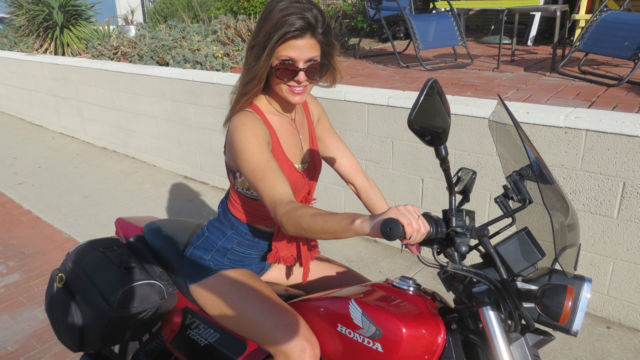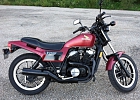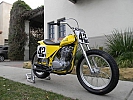1984 VT500 Ascot Red low miles RARE 500cc V-Twin 6 speed Old School Flat Track
1984 Honda VT 500 ASCOT
| Price: | US $3,784.00 |
| Item location: | Portland, Oregon, United States |
| Make: | Honda |
| Model: | VT 500 ASCOT |
| Type: | Standard |
| Year: | 1984 |
| Mileage: | 18,554 |
| VIN: | JH2PC1007EM100566 |
| Color: | Red |
| Engine size: | 491 |
| Vehicle Title: | Clear |
| Contact seller: | Contact form |
The Ascot VT500 is named for Ascot Park, California track where countless legends have been born and where I used to attendmotorcycle races in my youth! Wanted one of these when they first came out but could't afford one! This is the fourth Ascot I have owned ( 2 FTs & 2 VTs) and it is a very nice one.Decided to trim my collection so now is your chance --- You know you want it.Very realistic reserve soBID to OWN IT!
You are looking at a very nice example of a super fun motorcycle! Just over 18,554 miles on this Candy Red Metallic beauty! I have ridden the bike on a couple fairly long day rides and really enjoyed it. Runs, ides and handles very well - easily keeping up with much morepowerfullarger displacement bikes. Sounds great too -- always gets compliments. A real pleasure to ride. Bike has been in the Pacific NW since new and has been well cared for! I believe I am the 4th owner but not sure! Never damaged or abused.Accessories include veryspaciousand nice looking quick release Tourmaster sidebags and National windshield. Natalie says "This bike is Just Right!"
VIN:JH2PC1007EM100566
NOTICE: All Human models are over 18 years old & no Animals were harmed in the Photo Shoot process
Please fell free to contact me at 503-329-6555Vehicle is located in Redondo Beach California 90277 (Pacific Daylight Time Zone)RIDLEY'S RIDES is a privately held LLC
BUYER IS RESPONSIBLE FOR ALL ASPECTS OF SHIPPING INCLUDING ALL COSTS AND ARRANGEMENTS! RIDLEY'S RIDES WILL PROVIDE SHIPPER WITH PICK UP LOCATION THAT ISACCESSIBLETO LARGE TRUCKS!
TERMS & CONDITIONS
ALL VEHICLES SOLD AS-IS
RIDLEY’S RIDES reserves the right to cancel all bids and end an auction early at any time, hould the vehicle no longer be available for sale.The following terms of sale apply to all of our auctions.RIDLEY’S RIDESwelcomes all dealers and individuals to bid on our vehicles. Every vehicle we sell will have a clear title. I AM AVAILABLE 7 DAYS A WEEK to answer any questions you may have. Please call, IM RIDLEY @ 503-329-6555, mailinfo@ridleysrides.com. I look forward to meeting you in person or speaking with you by telephone.
* Successful high bidder should contactRIDLEY’S RIDESwithin 24 hours at503-329-6555.
* Successful high bidder will submit a $1,000.00 deposit in the form of a cashier's check, redit card, wire transfer or Pay-Pal within 24 hours of the auction ending, nless other arrangements have been made.
* This vehicle is being sold "as is", nless a warranty is in effect from the vehicle manufacturer.
* All financial transactions should be completed within 4 (four) days of an auction ending.
*RIDLEY’S RIDESaccepts cashier's checks, ertified funds, r wire transfers.
* The buyer is responsible for all shipping charges.RIDLEY’S RIDESgladly can help the buyer arrange all shipping and transportation using only licensed, onded and insured carriers that provide door-to-door delivery.
* Every effort has been made to accurately and fairly describe this vehicle.RIDLEY’S RIDESdiscloses all information known about this vehicle for auction. Please be advised that used vehicles may sometimes have miniscule scratches or dings inherent to their age / mileage and some mechanical parts could be subject to normal wear.RIDLEY’S RIDESwelcomes a buyer's inspection. If you plan on using a buyer's pre-purchase inspection, lease schedule your inspection appointment prior to the auction ending. The buyer is responsible for any and all inspection charges and fees
FUN FACTS/ SPECSFROM MCS
CYCLE WORLD 1983
The VT500FT'84 Ascot was sold in 1984 in one of two colors: Black or Red. The side cover panel on the black bike was silver, ut on the red bike it was black. The gas tank wing decal was 3-tone. The 2-into-1 exhaust system was black chrome. The engine was a 491 cc OHC 3-valve liquid cooledV-twinlinked to a 6-speed transmission and a shaft drive. The serial number began JH2PC070*EM100001.
Make Model
Honda VT 500FTAscotYear
1983Engine
Liquid cooled, our stroke, 2°V-twin, OHC, valves per cylinder.
Capacity
491Bore x Stroke71 x 62 mmCompression Ratio10.5:1Induction
2x 32mm Keihin carbsIgnition / Starting
Electronic / electricalMax Power
47.5 hp 34.6 kW @ 9000 rpmMax Torque
42 Nm @ 7000 rpmTransmission / Drive
6 Speed / shaftFront Suspension
Air assisted telescopic forks.Rear Suspension
Pivoted fork dual adjustable shocksFront Brakes
Single 280mm disc 2 piston calipersRear Brakes
DrumFront Tyre
100/90-18Rear Tyre
120/80-18Dry-Weight
177 kgFuel Capacity
17 LitresConsumption average
41.3 mp/gStanding ? Mile
13.6 sec / 94 mp/hTop Speed
122 mp/hThere are a lot of ways to look at a motorcycle's performance, nd in the rush to record elapsed time, op speed, ileage, raking distance, omfort, hatever, t's easy to overlook Fun.
Fun. All it takes is a ride on the Honda VT500 Ascot to remember how important Fun is.
But first, n identity problem. Make that two identity problems.
One, he Ascot VT500 is named for Ascot Park, California track where countless legends have been born. Team Honda races at Ascot and has won there. But they don't do either there with the Ascot VT500. For TT, onda runs a special-framed version of the XL600 Single. For the half mile, he factory uses the CX500-based NS750 or the Shadow 750-based RS750. Despite what the innocent may think they've seen on TV, he VT500 is not a racer, or is it related to the racers.
Two, here's the Ascot VT500, s seen here, nd the Ascot FT500, he same styling but with the XL500-de-rived air-cooled, hain drive Single, hat is, wo different bikes with a name in common. Next to the Ascot VT500 is the Shadow VT500C, hich shares engine and drivetrain with the VT500 Ascot but looks like the VT750C Shadow, hich in turn has a water-cooled V-Twin similar in principle but different in nearly every detail from the VT500 V-Twin.
Confusing. There will not be a quiz, ut for the sake of brevity, n this text references to the Ascot will mean the VT500 version, itto for the V-Twin, nless otherwise noted.
Luckily for us all, he styling department has done a more tidy job with this bike. With its small gas tank, lat seat, ntegrated side panels and sleek tail section, he Ascot looks like a track bike, n the blazing red shown here or is it related to the racers. the optional nearly black blue.
The engine is as successful and as interesting. The VT500 is off the same drawing board as the VT750, lthough there are no shared parts.
A 90° Vee has natural balance. A 45° Vee is compact and has an, m, raditional look. Honda and Yamaha are busily reinventing the V-Twin and both are looking for ways to get good balance and traditional compactness. Yamaha is using 70° Vees and going to counterbalances when the engine is designed to rev beyond traditional speeds. The Ascot has a 52° angle between the cylinders, ot for vibration control.
Honda's cure for imbalance is development of another idea, he offset crankpin. Har-ley, ucati, oto Guzzi and Yamaha Vees have both connecting rods on the same throw. The fore-and-aft Honda Vees have a throw (pin) for each cylinder, paced according to a formula that makes the connecting rods and pistons think they're spaced more widely than the cylinders are. They're also spaced side by side and that introduces another source of vibration, he rocking couple, ut as we'll see Honda's solution is workable if not perfect. The crankshaft itself is a one-piece forging, ith plain bearings and two-piece connecting rods.
There's more innovative engineering in the cylinder heads. To start with, he Ascot has three valves, wo intake and one exhaust, acked into a heart-shaped combustion chamber. The shape would push a single spark plug off center, o to speak, o there are two plugs per cylinder. Lighting the fire two places at once shortens flame travel and that means the engine will tolerate a high compression ratio with so-so fuel and moderate spark advance. We sort of hoped for a Twin version of the radial four-valve heads on the new Honda Singles, ut the factory reps say the two engine families are done by separate design teams. But, s with the offset crankpins, he three-valve, wo-plug head gives good results. The heads are low, ather than no, aintenance: the single overhead cam works the valves via rocker arms and clearance is adjusted with screw tappets. The timing chains tension automatically.
Top gear in the six-speed box is 0.931:1, .e. speeds up the output shaft, llowing Honda to fit another one of those "OD" lights on the instrument panel. Final drive is shaft, ith the usual bevel gears.
The Ascot's two 32mm Keihin CV carbs are linked to a single push-pull throttle drum and are fed by a horn-shaped chamber which fits between the frame backbone tubes and connects the carbs to an under-seat airbox and filter. The exhaust pipes both exit on the right side of the engine and meet in an expansion box under the swing arm pivot, n front of the rear wheel. Exhaust gasses exit through a single, arge muffler. The exhaust is finished in black chrome.
The frame is round steel tubing with dual front downtubes and twin backbone tubes. The steel swing arm runs in tapered roller bearings and is rectangular box-section on the right and round on the left, ince the left side encloses the driveshaft. There are two rear shock absorbers with adjustable preload.
The leading axle forks have 37mm stanchion tubes and individual air caps. There's a forged aluminum brace bolted between the two sliders, nd the lower triple clamp is steel.
The upper triple clamp is forged aluminum, nd the steering stem rides in ball bearings.
The tall, arrow radiator mounts between the frame downtubes and a compact electric fan sits behind it. A section of the right downtube unbolts to ease engine removal and installation, ut doesn't carry coolant as similar tubes do in some Hondas. Instead, etal tubes and rubber hoses link the cylinders with the water pump and radiator.
The headlight is rectangular, nd a plastic cover just below the headlight hides the single horn. The handlebars are short, ith little pullback. The instruments are housed in a square-edged panel. There's a mechanical 120-mph speedometer with odometer and re-settable trip meter, mechanical 10,000-rpm tachometer (redline is 9500 rpm), coolant temperature gauge, arning lights for oil pressure and taillight failure, nd indicator lights for turn signals, eutral, igh beam and OD. The ignition switch and fork lock is mounted with the instruments, hile the choke control lever is built into the left handlebar control pod.
Wheels are ^
Corn-Cast.
Honda's pressed-together combination of a cast aluminum hub and spokes and a hollow, xtruded aluminum rim. The front wheel is 2.15 x 18 in., he rear wheel 2.50 x 18 in., arrying a Bridgestone 3.50-18 L303 and a Bridgestone 4.25-18 G504 respectively. The single front disc brake has a twin-piston caliper. The rear brake is a mechanical drum.
The Ascot is in the hunt, specially if factors like retail price and ease of service are added to the equation.
There's more to the Ascot than numbers and some of what goes beyond numbers appears contradictory. Vibration. True, ibration is relative. Ride the Ascot after time on a Really Big Twin and the little Vee is smooth as a baby's cheek. Ride the Ascot after time on a Nighthawk 550 and the Twin feels like the washing machine sounds when one leg falls off and the washer starts running around the garage.
Back in class, he Ascot is normal for its type and size. Ever since the invention of the internal combustion engine there have been certain laws and limits, s in one cylinder is more difficult to balance than two, wo are more difficult than four, tc. Cylinders have been put in different places; side by side, n a variety of Vees, pposed to each other. There have been counterweights, ubber mounts, pposing crank pins, hared pins and now offset pins.
All of which has come to prove that what matters most are the size of the pistons and the state of engine tune. The VT500 doesn't shake things off, t doesn't blur the mirrors.
We rather like the sensation. Lets you know it's an engine. Good vibes, s they used to say. At the same time, espite no scientific measurement, e suspect that the Yamaha's low-stress Virago 500 and counterbalanced Vision 550 vibrate a bit less.
Because Honda offers all those other models 250 and 600 Singles, 50 and 650 Twins, wins with automatic transmissions and Twins with turbochargers, ight down to the Shadow VT500C, he same internals in a different body, onda gets to make the Ascot VT500 a definitely single purpose machine.
That purpose is sport. The seat is firm and sloped to keep the rider snug against the tank. The bars are narrow and low. The pegs are high. There is only only riding position, orderline cramped, dding an immediacy and slightly frantic quality to the rider's position, he same sort of no-frills quick-response seat and controls relationship found on a racebike.
the saddle, ith a 2.5-gal. gas tank and that narrow-narrow engine. There isn't a lot of mass before the rider's eyes. Maybe it's a case of out of sight, ut of mind, ut convincing an Ascot rider of the hard facts is difficult unless that rider mans the tape measure and scale himself.
The Ascot isn't the most comfortable motorcycle in the highway, ainly because of the seating position. The suspension plays a role here, oo, eing tailored for sporting use and also being non-adjustable except for shock preload and fork air pressure within the range of 0 to 6.0 psi. The forks work well enough, ut the shocks are not as compliant as we'd like over small bumps in the road surface, nd that's a compromise forced upon a sporting bike without adjustable suspension.
Oh, es. Suspension. We nearly forgot to mention the shaft drive. We nearly forgot because it's not noticed. The Ascot doesn't leap up under power or crouch when the throttle is rolled back. The engineers have used the correct swing arm length and swing arm pivot position and tuned the suspension damping to achieve what the others have said couldn't be done. Okay, he Ascot doesn't have great fistfuls of power and that helps not create driveshaft symptoms, ut even so, he only time the Ascot's drive-shaft comes to mind is when the chain doesn't need lube.
Cornering clearance is excellent and the rider has to work to drag the early-warning footpeg "feelers," which extend downward from the ends of the high, olding footpegs. The bike is stable in a straight line and in all sorts of corners. About the most distressing thing it ever does is hop the rear wheel slightly if the throttle is chopped going into a sharp corner.
Out on country roads the Ascot is at home, he rider busy running up and down the gears and setting up for this corner or that. It will pull at low rpm and plonk through city traffic, ut the Ascot is happiest reaching for the red-line, aking good power over 6000 rpm and best power be-
tween 7000 rpm and redline at 9500 rpm.
The Ascot reached 104 in the half mile and is geared for 107 at redline in 5th gear, hich is the gear used for the top speed runs. Sixth, hich Honda calls overdrive, ould be good for 123 at redline if the engine had the power to pull it, hich it doesn't. The advantage of that tall top gear is that the engine spins slower at cruising speeds, s in 4600 rpm at 60 in top.
Just as the Ascot feels lighter than it is, o does it feel more powerful than it is. This isn't a complaint, ecause the bike is certainly fast. Instead, t's surprising when cruising at speed to arrive at a grade or meet a headwind, each down for more throttle and discover there isn't as much left as you thought: oh yeah, t's only a 500.
There are some genuine complaints. The key switch is recessed below the instrument panel and it's awkWard to reach with gloved hands. The tank is smaller than it looks because of the wide tunnel needed for the hose from carbs to air box. Some of the crew didn't like the bend of the bars although because they're conventional style they can be swapped. The slick rear side panels shield the frame tubes so there's no place to attach luggage. (The grab handles recessed into the panels have tiny studs for bungee hooks, ut that's not enough.)
Passenger accommodations are impossible. The muffler is high so the passenger pegs are higher still. The rear portion of the seat is thin and short. It's legal but barely possible for a human being to perch there.
And now, he intangibles. The Ascot VT500 isn't the bike raced at Ascot. Honda's offset crankpins don't undermine the laws of physics. The suspension is stiff and the riding position cramped.
But the handling is crisp, he controls delightful and the engine responsive beyond its numbers. The Ascot is quick and sure and rewarding. The hype and compromises somehow fade away.
The Ascot is fun. B!
Source Cycle World 1983
Also published at eBay.com

















